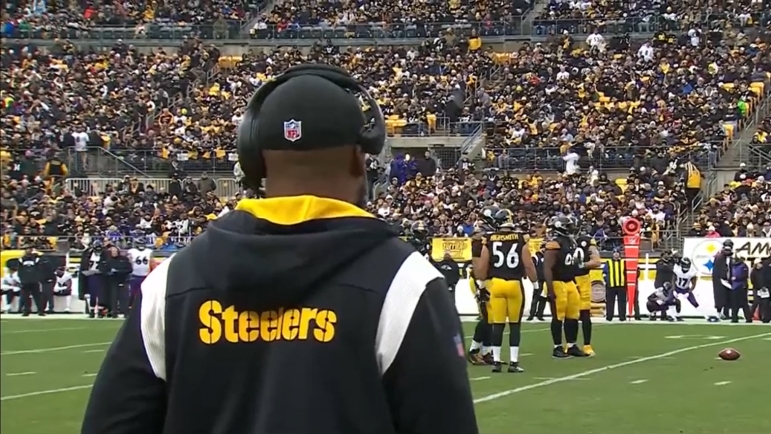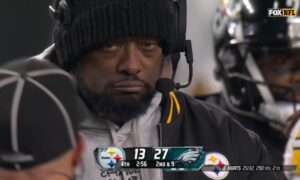Mike Tomlin, once one of the brightest young defensive minds in the NFL landscape, has often drawn praise for his ability to establish a winning culture in Pittsburgh and serve as a motivator in the locker room. While these aspects of his coaching style, along with his often-mentioned streak of 16 consecutive “non-losing seasons” since taking over as the team’s head coach in 2007, are the focus, not nearly enough attention is given to Tomlin’s growing mastery of defensive schematics.
A disciple of the Monte Kiffin, Tony Dungy, Tampa 2 coaching tree, Tomlin has continued to evolve his coverage schematics, deploying a mix of pre-snap disguise and post-snap rotation to flummox opposing quarterbacks with inverted coverage schemes, often allowing his vaunted pass rush personnel to get home. While Pittsburgh ran Cover 2 last season at a near league-high rate, the creative ways in which they get to these looks, along with a high collective football IQ in their secondary personnel, have proven to be a nightmare for quarterbacks in obvious passing situations.
The first of Pittsburgh’s primary coverage looks come from a simple, two-high safety, middle-of-the-field open coverage family, with a classic quarters coverage umbrella in the secondary. In reality, much of what Pittsburgh does from these looks is split field coverage, with this here being an example of Cover 7 quarters, a staple in Nick Saban’s Alabama defense.
To the field, Pittsburgh is aligned three over two, with TJ Watt, Damontae Kazee, and Levi Wallace in coverage, responsible for coverage on a pair of eligible receiving threats. Kazee is responsible for any vertical release of the #2 receiver, while Levi Wallace is responsible for any vertical release of the #1 receiver. As the #2 receiver eliminates on a shallow outside release, TJ Watt assumes coverage responsibilities, allowing Kazee to rob the vertical release of the #1 receiver.
The beauty of Cover 7 quarters is that by playing three over two, there will almost always be an effective double team on the vertical most route unless both receivers declare vertical. While the weakness of the coverage is that it asks TJ Watt and/or Alex Highsmith to function as man coverage defenders, Pittsburgh feels comfortable in their ability to match tight ends, making it an effective counter to 12 personnel sets.
On obvious passing downs, Pittsburgh likes to live in two-high safety looks, but will roll down into single-high, middle-of-the-field closed looks post-snap. Here, in a third and long situation, Pittsburgh aligns with their two-high, quarters coverage umbrella pre-snap, before rolling into Cover 3 “star” post-snap, with Minkah Fitzpatrick coming downhill as the “weak hook/curl” defender.
Coming out of the roof, Minkah does a nice job of playing top-down, planting his feet at the sticks, and occupying an intermediate throwing window to force the check-down. As Zach Wilson pulls the pin on an angle route to his back, well short of the sticks, Minkah plants and drives, closing space downhill, coming to balance, and securing a nice leg tackle well short of the sticks. While his overall coverage schemes deserve credit in confusing quarterbacks and generating takeaways, Tomlin, Austin, and company deserve credit for consistently putting Minkah Fitzpatrick in positions and coverage assignments that maximize his value.
Now back to the topic of Pittsburgh’s pre-snap disguise, and its role in maximizing their All-Pro safety, Minkah Fitzpatrick. Here, Pittsburgh aligns pre-snap with clear indicators of a split field coverage concept, with Mac Jones likely reading some variation of Cover 6 (quarter-quarter-half), given the pre-snap alignment and posture of the safeties, with Terrell Edmunds deep and Minkah playing tighter to the line, playing over #2 to a trips set.
Nonetheless, at the snap, Minkah pushes off the hash as a deep ½ dropper, both corners assume their flat zone duties, Robert Spillane becomes the Tampa backer, responsible for carrying the seam, and all of a sudden, Pittsburgh is in a traditional Tampa 2 defense. As Minkah pushes for depth and works over #2, Mac Jones declares his shoulders, targeting what he thinks is an isolated matchup with Devante Parker on Robert Spillane.
Unfortunately for Mac Jones, Pittsburgh happens to have a unicorn at safety, as Minkah flips his hips seamlessly, closes to the top shoulder of the #3 receivers working up the seam at the hashes, and high points the football for a beautiful interception. While Tampa 2 in itself is a relatively vanilla coverage, and one that is employed at all levels of football, the creativity in which Pittsburgh gets to these looks, generates confusion and forces errant decisions from opposing quarterbacks. Of course, having an All-Pro safety with the range and movement skills to execute otherworldly post-snap rotations certainly helps!
The next post-snap rotation, and one that has become a staple in Mike Tomlin’s sub-package repertoire, is an exchange of responsibilities between the boundary cornerback and safety, a rotation most commonly referred to as inverting coverage. Pre-snap, Pittsburgh once again aligns with split-field posture in the secondary, leaving the quarterback to potentially assume that some variation of Cover 3 Cloud may be deployed.
This time post-snap, Pittsburgh once again rolls into a Tampa 2 look, but this time, Levi Wallace replaces as a deep ½ defender, allowing Damontae Kazee to roll down and assume the responsibilities traditionally held by the flat zone cornerback. To the field side, Pittsburgh plays a traditional Tampa 2 look, with Cam Sutton serving as the flat defender and Minkah Fitzpatrick serving as the deep 1/2 defender. By only inverting to the boundary, Pittsburgh is able to generate confusion in Derek Carr’s initial read, while also protecting against a quick shot up the seam. As A result, the pocket collapses quickly and Carr is forced to lazily hit his check-down for a short gain, keeping Pittsburgh in a favorable position ahead of second down.
The next inverted coverage, Pittsburgh’s Invert Cover 3 scheme, is one that they will exclusively deploy out of their Dime package, and since 2019, has been executed exclusively by Cam Sutton, who has since departed via free agency. By aligning Cam Sutton as a linebacker in their Dime packages, the Steelers defense grants itself the personnel flexibility to execute difficult post-snap rotations that require range and athleticism.
After aligning pre-snap with what appears to be a traditional Cover 3 posture in the secondary, Cam Sutton, aligned at linebacker depth, rotates to the post, allowing both Minkah Fitzpatrick and Damontae Kazee to execute flat foot reads as “hook/curl” defenders. Pittsburgh relies on this concept in third and long situations, as it allows safeties to play at the sticks and force check-downs.
What will be interesting to see moving forward is whether Pittsburgh has a player on the roster who they trust to execute such difficult post-snap rotations. While Patrick Peterson is the likely name Pittsburgh tries at the start of next season, he, at his current age, lacks the range and athleticism that Pittsburgh lost in Cam Sutton.
Yet another look that Pittsburgh executes via post-snap rotation is this one here, which famously culminated in a game-sealing interception courtesy of Cam Sutton, keeping their playoff hopes alive. Pre-snap, it would be extremely difficult for Derek Carr to decipher what Pittsburgh will roll into coverage-wise. With Levi Wallace and James Pierre close to the line, Minkah Fitzpatrick playing from depth in the post, and Sutton and Kazee playing at different levels inside the numbers, a split-field coverage concept is likely the read from the opposing quarterback.
At the snap, Pittsburgh once again shifts into an inverted Tampa 2 look, this time getting creative with Minkah Fitzpatrick inserting as the Tampa backer, with Sutton and Kazee pushing off the hashes as the deep ½ defenders. While Vegas runs a perfect concept to occupy Minkah to attack the coverage, Sutton shows phenomenal hip fluidity and range to close from the numbers to the hash, arrive at the upfield shoulder, and secure a game-sealing interception.
This is now the third distinct way that we have seen Pittsburgh rotate to a Tampa 2 coverage look in this article alone. Mike Tomlin, a one-time Tampa 2 disciple under Monte Kiffin, has reinvented the coverage and deployed it effectively as a sub-package off-speed pitch to confuse opposing quarterbacks. It will be fascinating to see how Sutton’s departure affects the deployment of these inverted coverages heading into next season, and who, if anyone, ultimately assumes that sub-package role in Pittsburgh’s defense.
Overall, it is clear that Pittsburgh’s pre-snap disguise and post-snap rotations are in a class of their own league-wide, particularly when operating from sub-package personnel. In that respect, Mike Tomlin, along with his top assistants in Teryl Austin and Grady Brown, deserves plenty of credit.
While elite pass rush personnel and arguably the game’s best safety certainly help, Tomlin and company routinely put them in the best positions to succeed, and have played a large part in the unit’s takeaway-oriented mindset. Of course, stopping the run is a massive element in allowing the coaching staff to deploy their sub-package creativity. In that respect, it is no wonder that a vastly improved run defense (32nd to 9th), led to improvements in both scoring defense (24th to 10th) and interceptions (19th to 1st).
While wholesale personnel changes on the backend, including the departures of long-time veteran starters in Cam Sutton and Terrell Edmunds, could lead to early lapses, Pittsburgh’s front office has placed a clear emphasis on football IQ and ball skills in their secondary. In that respect, Minkah Fitzpatrick, Damontae Kazee, Levi Wallace, and Patrick Peterson should help set the standard while the incoming young talent gets up to speed.








